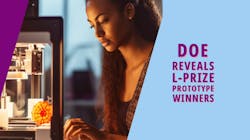This week, the U.S. Department of Energy announced the winners of the L-Prize program’s Prototype Phase, the second stage of the competition which opened for submissions in June 2022 and closed for evaluation this past June.
The L-Prize competition, which debuted in 2008 as the Bright Tomorrow Lighting Prize, was developed to influence the lighting industry’s march toward greater LED lamp performance and lifetime, and spawned the distinctive yellow 60W lamp replacement from the former Philips Lighting business. The competition was shuttered for a period and subsequently relaunched in 2021 to advance commercial LED lighting systems. It is led by the DOE’s Building Technologies Office and administered by the National Renewable Energy Laboratory with technical support from Pacific Northwest National Laboratory (PNNL).
The L-Prize competition is composed of three phases — Concept, Prototype, and Manufacturing & Installation — with points eligibility across logistics, performance, and accessibility related criteria.
In February 2022, U.S. Energy Secretary Jennifer Granholm announced the Concept Phase winners during the DOE’s virtual Solid-State Lighting Workshop. The four winning Concept teams included QuarkStar’s Project Tango, Orion Energy Systems, Smash the Bulb and Bridgelux, and Papaya. Learn more about those concepts in an article by L-Prize advisor Kate Hickcox of PNNL.
Prototype Phase entrants were not required to participate in the Concept Phase. Entrants were encouraged to form teams and submit working prototypes that exceed the capabilities of the current commercial lighting market in two categories: Luminaires and Connected Systems. All submissions were judged on minimum requirements including quality of light, efficacy, connectivity, and product life cycle, but considerations such as sustainable materials, value proposition and cost, circularity, and others would make all the difference in ingenuity, as outlined by PNNL’s Gabe Arnold in November 2022. Six winners were selected and share a prize pool of $2 million between them.
Luminaire Track winners and their prizes include:
- Generation Flex: Light Without Compromise, submitted by Signify Innovation, Bridgewater, New Jersey ($375,000) — A modular, 3D-printed luminaire integrating a DALI D4i driver for bidirectional connectivity and data communications.
- Low-Carbon Biodegradable Luminaire, submitted by Lightly, Boothwyn, Pa. ($375,000) — Building on its low carbon-footprint mission, Lightly’s linear luminaire relies upon U.S. sourced biodegradable alternatives to plastic and metal.
- Helios HPR-LP160, submitted by Grid Interactive Efficient Building Alliance (GiEBA), San Diego, Calif. ($250,000) — The 2x4-foot troffer integrates wireless Google Thread networking technology and is designed for end-of-life disassembly and recycling.
Connected Systems winners and their prizes include:
- Interact Next-Gen: Light the Way to Building Goals, submitted by Signify Innovation, Bridgewater, New Jersey ($375,000) — The system offers a user-friendly interface, role-based functions for managing user needs, a multifunction sensor, and energy harvesting switches as part of a wireless approach to interfacing with additional building systems.
- Autani Insights 4REAL, with Sensing by Leviton, submitted by Autani and Leviton, Columbia, Maryland ($375,000) — Based on open standard protocols, the system is available with tiered options to serve customers with various levels of lighting controls experience.
- Bluetooth Mesh Wireless Lighting Control System, submitted by McWong International, Sacramento, Calif. ($250,000) — The Bluetooth mesh protocol is leveraged to allow use off-the-shelf components, and a configuration commissioning report helps users manage control narratives.
According to Building Technologies Office director Mandy Mahoney, “The winning prototypes represent ground-breaking innovation, not only in energy efficiency, data-driven connectivity, and environmental sustainability, but also prioritizing communities that get overlooked when we roll out new prototypes.”
The final phase opens on Dec. 15, 2023 and is scheduled to close on April 26, 2025. Prototype winners are encouraged to participate in the Manufacturing & Installation phase, but it is open to those who had not participated in prior L-Prize phases. You can follow the American-Made Challenges timeline page for L-Prize updates.
CARRIE MEADOWS is editor-in-chief of LEDs Magazine, with 20-plus years’ experience in business-to-business publishing across technology markets including solid-state technology manufacturing, fiberoptic communications, machine vision, lasers and photonics, and LEDs and lighting.
Follow our LinkedIn page for our latest news updates, contributed articles, and commentary, and our Facebook page for events announcements and more. You can also find us on the X platform.




